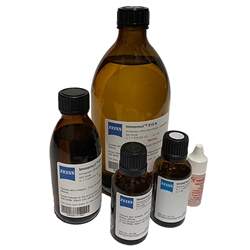Typical high magnification lenses are 40x and 97x or 100x. In places where there is no sample and the condensers numerical aperture is greater than the objectives the oblique rays cross each.
Immersion Oil 500 Ml Zubehor Histology Microscopy Life Science Carl Roth International
Several different types of grid should be used when pathology specimens are being examined to ensure correct identification of exogenous material.
. The most frequently used objective lens is the 10x lens which gives a final magnification of 100x with a 10x ocular lens. The latter two magnifications are used exclusively with oil in. Thick apertures should be used to prevent X-rays generated higher in the column from reaching the specimen and the objective aperture must be removed during analysis to eliminate X-rays from this source.
Φ the angle between privileged directions of the polarizer and analyzer in most cases 90 o τ the angle between the polarizers privileged direction and the crystals closest. For very small protists and for details in prepared slides such as cell organelles or mitotic figures you will need a higher magnification. In this case the of light transmitted by the analyzer L depends on.
First we will consider only the case of a single wavelength of light monochromatic light as being incident on the crystal from below. The top lens of a simple Abbe darkfield condenser is spherically concave allowing light rays emerging from the surface of the top lens to form an inverted hollow cone of light with the focus centered on the specimen plane.

Zeiss Objective Chart Macro Lens Photography Macro Photography Art Photography Camera
Immersion Oil 50 Ml Glass Zubehor Histology Microscopy Life Science Carl Roth International

0 Comments